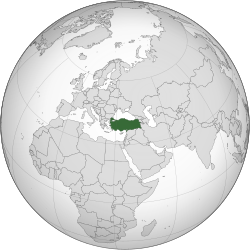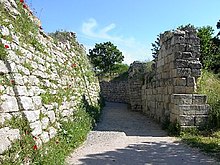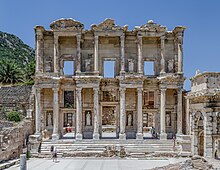This is an old revision of this page, as edited by Hazhk (talk | contribs) at 12:55, 12 August 2012 (The emblem is unofficial. Don't people question why it wasn't previously there?). The present address (URL) is a permanent link to this revision, which may differ significantly from the current revision.
Revision as of 12:55, 12 August 2012 by Hazhk (talk | contribs) (The emblem is unofficial. Don't people question why it wasn't previously there?)(diff) ← Previous revision | Latest revision (diff) | Newer revision → (diff)| Republic of TurkeyTürkiye Cumhuriyeti | |
|---|---|
 Flag
Flag | |
| Anthem: İstiklal Marşı Independence March | |
 Location of Turkey Location of Turkey | |
| Capital | Ankara |
| Largest city | Istanbul |
| Official languages | Turkish |
| Demonym(s) | Turkish |
| Government | Parliamentary republic |
| • Founder | Mustafa Kemal Atatürk |
| • President | Abdullah Gül |
| • Prime Minister | Recep Tayyip Erdoğan |
| • Speaker of the Parliament | Cemil Çiçek |
| • President of the Constitutional Court | Haşim Kılıç |
| Legislature | Grand National Assembly |
| Succession to the Ottoman Empire | |
| • Treaty of Lausanne | 24 July 1923 |
| • Declaration of Republic | 29 October 1923 |
| Area | |
| • Total | 783,562 km (302,535 sq mi) (37th) |
| • Water (%) | 1.3 |
| Population | |
| • 2011 estimate | 74,724,269 (18th) |
| • 2000 census | 67,803,927 |
| • Density | 97/km (251.2/sq mi) (108th) |
| GDP (PPP) | 2011 estimate |
| • Total | $1.073 trillion (16th) |
| • Per capita | $14,517 (64th) |
| GDP (nominal) | 2011 estimate |
| • Total | $778.089 billion (18th) |
| • Per capita | $10,522 (62nd) |
| Gini (2008) | 39.0 Error: Invalid Gini value |
| HDI (2011) | Error: Invalid HDI value (92nd) |
| Currency | Turkish lira (TRY) |
| Time zone | UTC+2 (EET) |
| • Summer (DST) | UTC+3 (EEST) |
| Date format | dd/mm/yyyy (AD) |
| Drives on | Right |
| Calling code | 90 |
| ISO 3166 code | TR |
| Internet TLD | .tr |
Turkey (Template:Lang-tr), known officially as the Republic of Turkey (Türkiye Cumhuriyeti), is a Eurasian country located in Western Asia (mostly in the Anatolian peninsula) and in East Thrace in Southeastern Europe. Turkey is bordered by eight countries: Bulgaria to the northwest; Greece to the west; Georgia to the northeast; Armenia, Azerbaijan (the exclave of Nakhchivan) and Iran to the east; and Iraq and Syria to the southeast. The Mediterranean Sea and Cyprus are to the south; the Aegean Sea is to the west; and the Black Sea is to the north. The Sea of Marmara, the Bosphorus and the Dardanelles (which together form the Turkish Straits) demarcate the boundary between East Thrace and Anatolia; they also separate Europe and Asia.
Turkey is one of the six independent Turkic states. The vast majority of the population is Muslim. The country's official language is Turkish, whereas Kurdish and Zazaki languages are spoken by Kurds and Zazas, who together constitute 18-25% of the population.
Oghuz Turks began migrating into the area now called Turkey (derived from the Medieval Latin Turchia, i.e. "Land of the Turks") in the 11th century. The process was greatly accelerated by the Seljuk victory over the Byzantines at the Battle of Manzikert. Several small beyliks and the Seljuk Sultanate of Rûm ruled Anatolia until the Mongol invasion. Starting from the 13th century, the Ottoman beylik united Anatolia and created an empire encompassing much of Southeastern Europe, Western Asia and North Africa. After the Ottoman Empire collapsed following its defeat in World War I, parts of it were occupied by the victorious Allies. A cadre of young military officers, led by Mustafa Kemal Atatürk and his colleagues, organized a successful resistance to the Allies; in 1923, they would establish the modern Republic of Turkey with Atatürk as its first president.
Turkey is a democratic, secular, unitary, constitutional republic with a diverse cultural heritage. Turkey has become increasingly integrated with the West through membership in organisations such as the Council of Europe, NATO, OECD, OSCE and the G-20 major economies. Turkey began full membership negotiations with the European Union in 2005, having been an associate member of the European Economic Community since 1963 and having joined the EU Customs Union in 1995. Turkey has also fostered close cultural, political, economic and industrial relations with the Middle East, the Turkic states of Central Asia and the African countries through membership in organisations such as the Turkic Council, Joint Administration of Turkic Arts and Culture, Organisation of Islamic Cooperation and the Economic Cooperation Organisation.
Turkey's location at the crossroads of Europe and Asia makes it a country of significant geostrategic importance. Given its strategic location, large economy and military strength, Turkey is a major Middle Eastern regional power.
Etymology
Main article: Name of TurkeyThe name of Turkey, Türkiye in the Turkish language, can be divided into two components: the ethnonym Türk and the abstract suffix –iye meaning "owner", "land of" or "related to" (derived from the Arabic suffix –iyya, which is similar to the Greek and Latin suffixes –ia). The first recorded use of the term "Türk" or "Türük" as an autonym is contained in the Orkhon inscriptions of the Göktürks (Celestial Turks) of Central Asia (c. 8th century). The English word "Turkey" is derived from the Medieval Latin Turchia (c. 1369). The Greek cognate of this name, Tourkia (Template:Lang-el) was originally used by the Byzantines to describe medieval Hungary (since pre-Magyar Hungary was occupied by proto-Turkic and Turkic tribes, such as the Huns, Avars, Bulgars, Kabars, Pechenegs and Cumans.) Similarly, the medieval Khazar Empire, a Turkic state on the northern shores of the Black and Caspian seas, was referred to as Tourkia (Land of the Turks) in Byzantine sources. However, the Byzantines later began using this name to define the Seljuk-controlled parts of Anatolia in the centuries that followed the Battle of Manzikert in 1071.
History
Main article: History of TurkeyAntiquity
Main article: History of Anatolia
The Anatolian peninsula, comprising most of modern Turkey, is one of the oldest permanently settled regions in the world. Göbekli Tepe is the site of the oldest known man-made religious structure, a temple dating to 10,000 BC, while Çatalhöyük is a very large Neolithic and Chalcolithic settlement in southern Anatolia, which existed from approximately 7500 BCE to 5700 BCE. It is the largest and best-preserved Neolithic site found to date and in July 2012 was inscribed as a UNESCO World Heritage Site.

The settlement of Troy started in the Neolithic and continued into the Iron Age. Through recorded history, Anatolians have spoken Indo-European, Semitic and Kartvelian languages, as well as many languages of uncertain affiliation. In fact, given the antiquity of the Indo-European Hittite and Luwian languages, some scholars have proposed Anatolia as the hypothetical center from which the Indo-European languages radiated. The earliest recorded inhabitants of Anatolia were the Hattians and Hurrians, non-Indo-European peoples who inhabited the Central Anatolia and Eastern Anatolia, respectively, as early as ca. 2300 BC. Indo-European Hittites came to Anatolia and gradually absorbed Hattians and Hurrians ca. 2000–1700 BC. The first major empire in the area was founded by the Hittites, from the eighteenth through the 13th century BC. The Assyrians conquered and settled parts of southeastern Turkey as early as 1950 BC until the year 612 BC. Following the collapse of the Hittite empire c. 1180 BC, the Phrygians, an Indo-European people, achieved ascendancy in Anatolia until their kingdom was destroyed by the Cimmerians in the 7th century BC.<ref name="TroyHittiteEmpirePhrygians">{{cite web|url=http://www.metmuseum.org/toah/ht/03/waa/ht0
- Cite error: The named reference
2011statwas invoked but never defined (see the help page). - Cite error: The named reference
2000trcensuswas invoked but never defined (see the help page). - ^ "IMF World Economic Outlook Database, April 2012". International Monetary Fund. 2012. Retrieved 17 April 2012.
- "Gini Index". World Bank. Retrieved 2 March 2011.
- The Turkish lira (Türk Lirası, TL) replaced the Turkish new lira on 1 January 2009.
- National Geographic Atlas of the World (7th ed.). Washington, D.C.: National Geographic. 1999. ISBN 0-7922-7528-4. "Europe" (pp. 68–69); "Asia" (pp. 90–91): "A commonly accepted division between Asia and Europe ... is formed by the Ural Mountains, Ural River, Caspian Sea, Caucasus Mountains, and the Black Sea with its outlets, the Bosporus and Dardanelles."
- KONDA Research and Consultancy (25 June 2011). "Religion, Secularism and the Veil in daily life" (PDF). Milliyet. Archived from the original (PDF) on 25 March 2009.
- "CIA World Factbook gives 18% Kurds". Cia.gov. Retrieved 16 May 2011.
- Sandra Mackey , “The reckoning: Iraq and the legacy of Saddam”, W.W. Norton and Company, 2002. Excerpt from pg 350: “As much as 25% of Turkey is Kurdish.”
- "Turkey – Turkish Origins". Countrystudies.us. Retrieved 16 May 2011.
- Mango, Andrew (2000). Atatürk. Overlook. ISBN 1-58567-011-1.
- Shaw, Stanford Jay (1977). History of the Ottoman Empire and Modern Turkey; Vol.1, Empire of the Gazis. the rise and decline of the Ottoman Empire, 1280–1808. Cambridge University Press. ISBN 0-521-29163-1.
{{cite book}}: Unknown parameter|coauthors=ignored (|author=suggested) (help) - ^ "Turkey and Russia on the Rise". Stratfor. 17 March 2009. Retrieved 21 August 2011.
- "Can Turkey Be a Source of Stability in the Middle East?". heptagonpost.com. 18 December 2010. Retrieved 16 May 2011.
- Harper, Douglas (2001). "Turk". Online Etymology Dictionary. Retrieved 24 May 2011.
- Jenkins, Romilly James Heald (1967). De Administrando Imperio by Constantine VII Porphyrogenitus. Corpus fontium historiae Byzantinae (New, revised ed.). Washington, D.C.: Dumbarton Oaks Center for Byzantine Studies. ISBN 0-88402-021-5. According to Constantine Porphyrogenitus, writing in his De Administrando Imperio (ca. 950 AD) "Patzinakia, the Pecheneg realm, stretches west as far as the Siret River (or even the Eastern Carpathian Mountains), and is four days distant from Tourkias (i.e. Hungary)."
- Istvan Baan: "Byzanz und Ostmitteleuropa, 950–1453". Page 46.
- "The World's First Temple". Archaeology magazine. Nov/Dec 2008. p. 23.
{{cite web}}: Check date values in:|date=(help) - Çatalhöyük added to UNESCO World Heritage List Global Heritage Fund blog article
- Balter, Michael (27 February 2004). "Search for the Indo-Europeans: Were Kurgan horsemen or Anatolian farmers responsible for creating and spreading the world's most far-flung language family?". Science. 303 (5662): 1323. doi:10.1126/science.303.5662.1323. PMID 14988549.
- "Ziyaret Tepe – Turkey Archaeological Dig Site". uakron.edu. Retrieved 4 September 2010.
- "Assyrian Identity In Ancient Times And Today'" (PDF). Retrieved 4 September 2010.
Cite error: There are <ref group=dn> tags on this page, but the references will not show without a {{reflist|group=dn}} template (see the help page).